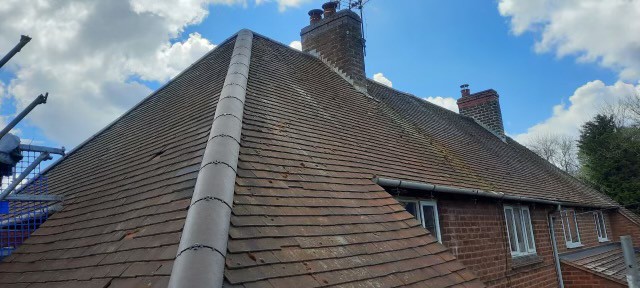Since the introduction of BS 5534, dry ridge systems are now a building control requirement on all new roofs, however they are not a control requirement for repairs to existing roofs which may have been previously done with traditional sand and cement.
If you are looking to update your roof, although you are not required to replace your ridge with a dry ridge, it may be worth looking into.
This blog aims to give you a full break down into what is a dry ridge and how they can benefit your roof.
What is a dry ridge system?
A dry ridge system is an alternative method to mortar of fixing ridge tiles to the roof. The general process involves a roll out membrane for ventilation, mechanically fixed plastic unions and metal screw fixings. Where replacing a mortar bed ridge line for dry ridge, the existing ridge tiles will be removed and cleaned and then re-fixed using a dry ridge kit.
What is the alternative to a dry ridge?
The alternative to a dry ridge is a wet ridge. A wet ridge is the more traditional roofing technique of using sand and cement to bind the ridge to the roof tiles.
Wet ridges are a cheaper alternative to dry ridges; however they are not long lasting and require regular maintenance.
A wet ridge is recommended to homeowners who are either on a tight budget or require a more traditional roofing technique to fit with the aesthetics of a period property.
What are the benefits of having a dry ridge verses the alternative?
- Longer lasting – As dry ridge systems are mortar free and each tile is mechanically attached, the whole system is much stronger and are tested to withstand extreme weather conditions, requiring minimal to no maintenance over the lifespan of the roof. The alternative traditional mortar application often requires maintenance every 5 years.
- Variety of shapes and colours – There is a vast variety of shapes and colours for dry ridge systems out there, giving you a choice on a style that suites your home and taste perfectly.
- Helps improve roof ventilation – Because there is no mortar involved attaching the ridge to the roof tiles, this means that a gap can be left around the ridge allowing for ventilation. This is particularly handy in the winter months when a roof needs lots of ventilation to prevent condensation when the heaters are switched back on in the home.
Considering the costs of wet and dry ridges
If you are considering either of these systems, it may be worth speaking with your roofing contractor on which option is best. Some contractors may quote up to double for a dry ridge system whereas others may offer a negligible saving for wet fix ridges. This is because even though dry ridge systems cost more in materials, they are generally less labour intensive against re-bedding ridges, therefore making both methods a similar cost.
Send in the professionals!
If you are looking to have your ridge updated or replaced, and are interested in having a dry ridge installed, its always best to have the work done by a professional.
Here at Kidderminster Roofing Contracts ltd, we can provide a free no obligation quotation for any roof maintenance, repair or replacement request. Contact us today to see how we can help with you!
Tel: 01562 748270
Email: office@kidderminsterroofing.com
Or drop us a message on Facebook!







